Accelerating the Delivery of Low-Carbon Buildings by Addressing Common Constraints: Perspectives from High-Rise, High-Density Cities
Abstract
:1. Introduction
1.1. Carbon Emissions and Buildings in High-Rise, High-Density Cities
1.2. Low-Carbon Buildings (LCBs)
1.3. Constraints to Delivering LCBs and Strategies to Accelerate the Delivery of LCBs
1.4. Research Gap and the Aim of the Present Study
2. Methods
2.1. Methods Used for Identifying and Analysing the Constraints
2.2. Methods Used for Identifying Strategies
Methods Used for Social Network Analysis of Constraints and Strategies
3. Results and Analyses
3.1. Constraints to Delivering LCBs and the Interdependencies among the Constraints
3.2. Strategies for Accelerating the Delivery of LCBs
3.3. SNA-Based Mapping and Analysis of Constraints and Strategies
4. Discussion
4.1. Formulating and Implementing Adequate Policies, Regulations, Standards, Codes, and Certifications
4.2. Effective Utilisation of Building Energy and Carbon Data
4.3. Awareness Raising, Training, and Information Dissemination
4.4. Technology Advancement
4.5. Incentives for Low-Carbon Adoption
4.6. Organisational Level Commitments and Policy Initiatives
5. Conclusions
Author Contributions
Funding
Data Availability Statement
Conflicts of Interest
References
- Intergovernmental Panel on Climate Change [IPCC]. Climate Change 2014 Synthesis Report Summary for Policymakers. 2014. Available online: https://www.ipcc.ch/pdf/assessmentreport/ar5/syr/AR5_SYR_FINAL_SPM.pdf (accessed on 8 January 2022).
- Mardiana, A.; Riffat, S.B. Building Energy Consumption and Carbon dioxide Emissions: Threat to Climate Change. J. Earth Sci. Clim. Chang. 2015. [Google Scholar] [CrossRef] [Green Version]
- Ahmed, A.K.; Ahmad, M.; Yusup, Y. Issues, Impacts, and Mitigations of Carbon Dioxide Emissions in the Building Sector. Sustainability 2020, 12, 7427. [Google Scholar] [CrossRef]
- Pérez-Lombard, L.; Ortiz, J.; González, R.; Maestre, I. A review of benchmarking, rating and labelling concepts within the framework of building energy certification schemes. Energy Build. 2009, 41, 272–278. [Google Scholar] [CrossRef]
- Kennedy, C.; Cuddihy, J.; Engel-Yan, J. The Changing Metabolism of Cities. J. Ind. Ecol. 2007, 11, 43–59. [Google Scholar] [CrossRef]
- Hunt, A.; Watkiss, P. Climate change impacts and adaptation in cities: A review of the literature. Clim. Chang. 2011, 104, 13–49. [Google Scholar] [CrossRef] [Green Version]
- Saroglou, T.; Meir, I.; Theodosiou, T.; Givoni, B. Towards energy efficient skyscrapers. Energy Build. 2017, 149, 437–449. [Google Scholar] [CrossRef]
- United Nations Department of Economic and Social Affairs [UN DESA]. 68% of the World Population Projected to Live in Urban Areas by 2050, Says UN. 2018. Available online: https://www.un.org/development/desa/en/news/population/2018-revision-of-world-urbanization-prospects.html (accessed on 23 January 2023).
- Pan, W.; Pan, M. A dialectical system framework of zero carbon emission building policy for high-rise high-density cities: Perspectives from Hong Kong. J. Clean. Prod. 2018, 205, 1–13. [Google Scholar] [CrossRef]
- Madhusanka, N.; Pan, W.; Kumaraswamy, M. Constraints to Delivering Low Carbon Buildings in High-Rise High-Density Cities. In Proceedings of the 37th Annual ARCOM Conference, Leeds, UK, 6–7 September 2021; pp. 804–813. [Google Scholar]
- Hong Kong Environment Bureau [HKEB]. Energy Saving Plan for Hong Kong’s Built Environment 2015–2025. 2015. Available online: http://www.enb.gov.hk/sites/default/files/pdf/EnergySavingPlanEn.pdf (accessed on 7 March 2022).
- Jones, P.; Lannon, S.; Patterson, J. Retrofitting existing housing: How far, how much? Build. Res. Inf. 2013, 41, 532–550. [Google Scholar] [CrossRef]
- Alam, M.; Zou, P.; Stewart, R.; Bertone, E.; Sahin, O.; Buntine, C.; Marshall, C. Government championed strategies to overcome the barriers to public building energy efficiency retrofit projects. Sustain. Cities Soc. 2019, 44, 56–69. [Google Scholar] [CrossRef]
- Ministry of Climate Change and Environment [MOCCAE]. National Climate Change Planof the United Arab Emirates 2017–2050. 2021. Available online: https://www.moccae.gov.ae/assets/30e58e2e/national-climate-change-plan-for-the-united-arab-emirates-2017-2050.aspx (accessed on 13 October 2021).
- Building and Construction Authority [BCA]. Green Building Masterplans. 2021. Available online: https://www1.bca.gov.sg/buildsg/sustainability/green-building-masterplans (accessed on 15 September 2021).
- International Energy Agency [IEA]. Energy Efficiency 2020. 2020. Available online: https://iea.blob.core.windows.net/assets/59268647-0b70-4e7b-9f78-269e5ee93f26/Energy_Efficiency_2020.pdf (accessed on 4 April 2022).
- International Energy Agency [IEA]. Estimated Global Buildings Construction in the Sustainable Development Scenario, 2018–2030. 2019. Available online: https://www.iea.org/data-and-statistics/charts/estimated-global-buildings-construction-in-the-sustainable-development-scenario-2018-2030 (accessed on 8 January 2022).
- Regulatory Indicators for Sustainable Energy [RISE]. Indicators. 2021. Available online: https://rise.esmap.org/indicators (accessed on 4 May 2021).
- Berke, P.R. Does Sustainable Development Offer a New Direction for Planning? Challenges for the Twenty-First Century. J. Plan. Lit. 2002, 17, 21–36. [Google Scholar] [CrossRef]
- Chan, E.H.W.; Lee, G.K.L. Design-led sustainable urban renewal approach for Hong Kong. HKIA J. 2006, 46, 76–81. [Google Scholar]
- Isiadinso, S.; Goodhew, S.; Marsh, J.; Hoxley, M. Identifying an appropriate approach to judge low carbon buildings. Struct. Surv. 2011, 29, 436–446. [Google Scholar] [CrossRef] [Green Version]
- Bhatt, N. Low Carbon Building. Climate CoLab. 2016. Available online: https://www.climatecolab.org/contests/2016/buildings/c/proposal/1329602#:~:text=Low%2Dcarbon%20buildings%20(LCB),would%20qualify%20as%20a%20LCB (accessed on 25 October 2022).
- Farhan, S.A.; Shafiq, N.; Azizli, K.A.M.; Jamaludin, N.; Gardezi, S.S.S. Low-Carbon Buildings: Renewable Energy Systems, Materials and Assessment Methods. Aust. J. Basic Appl. Sci 2014, 8, 260–263. [Google Scholar]
- Pan, W.; Ning, Y. A socio-technical framework of zero-carbon building policies. Build. Res. Inf. 2015, 43, 94–110. [Google Scholar] [CrossRef]
- Global Alliance for Buildings and Construction [GABC]. 2019 Global Status Report for Buildings and Construction: Towards a Zero-Emission, Efficient and Resilient Buildings and Construction Sector. 2019. Available online: https://www.worldgbc.org/sites/default/files/2019%20Global%20Status%20Report%20for%20Buildings%20and%20Construction.pdf (accessed on 10 September 2022).
- Pan, W.; Pan, M. Opportunities and risks of implementing zero-carbon building policy for cities: Hong kong case. Appl. Energy 2019, 256, 113835. [Google Scholar] [CrossRef]
- Pan, W.; Pan, M. Drivers, barriers and strategies for zero carbon buildings in high-rise high-density cities. Energy Build. 2021, 242, 110970. [Google Scholar] [CrossRef]
- Mata, É.; Peñaloza, D.; Sandkvist, F.; Nyberg, T. What is stopping low-carbon buildings? A global review of enablers and barriers. Energy Res. Soc. Sci. 2021, 82, 102261. [Google Scholar] [CrossRef]
- Madhusanka, N.; Pan, W.; Kumaraswamy, M. Constraints to low-carbon building: Perspectives from high-rise high-density cities. Energy Build. 2022, 275, 112497. [Google Scholar] [CrossRef]
- Jiang, M.P.; Tovey, K. Overcoming barriers to implementation of carbon reduction strategies in large commercial buildings in China. Build. Environ. 2010, 45, 856–864. [Google Scholar] [CrossRef]
- Baek, C.; Park, S. Policy measures to overcome barriers to energy renovation of existing buildings. Renew. Sustain. Energy Rev. 2012, 16, 3939–3947. [Google Scholar] [CrossRef]
- Zhang, Y.; Wang, Y. Barriers’ and policies’ analysis of China’s building energy efficiency. Energy Policy 2013, 62, 768–773. [Google Scholar] [CrossRef]
- Gupta, P.; Anand, S.; Gupta, H. Developing a roadmap to overcome barriers to energy efficiency in buildings using best worst method. Sustain. Cities Soc. 2017, 31, 244–259. [Google Scholar] [CrossRef]
- Reddy, B.S. Barriers and drivers to energy efficiency—A new taxonomical approach. Energy Convers. Manag. 2013, 74, 403–416. [Google Scholar] [CrossRef] [Green Version]
- Andrić, I.; Koc, M.; Al-Ghamdi, S. A review of climate change implications for built environment: Impacts, mitigation measures and associated challenges in developed and developing countries. J. Clean. Prod. 2019, 211, 83–102. [Google Scholar] [CrossRef]
- Madhusanka, N.; Pan, W.; Kumaraswamy, M. Social Network Analysis of Building Energy and Carbon Policy Networks in Developing Countries. IOP Conf. Ser. Earth Environ. Sci. 2020, 588, 022004. [Google Scholar] [CrossRef]
- Iwaro, J.; Mwasha, A. A review of building energy regulation and policy for energy conservation in developing countries. Energy Policy 2010, 38, 7744–7755. [Google Scholar] [CrossRef]
- Zhang, L.; Li, Q.; Zhou, J. Critical factors of low-carbon building development in China’s urban area. J. Clean. Prod. 2017, 142, 3075–3082. [Google Scholar] [CrossRef]
- Li, Y.; Zhu, N.; Qin, B. Major Barriers to the New Residential Building Energy-Efficiency Promotion in China: Frontlines’ Perceptions. Energies 2019, 12, 1073. [Google Scholar] [CrossRef] [Green Version]
- Pan, W.; Li, K.; Teng, Y. Briefing: Life-cycle carbon assessment of prefabricated buildings: Challenges and solutions. Proc. Inst. Civ. Eng.—Eng. Sustain. 2019, 172, 3–8. [Google Scholar] [CrossRef]
- Yu, C.; Pan, W.; Zhao, Y.; Li, Y. Challenges for Modeling Energy Use in High-rise Office Buildings in Hong Kong. Procedia Eng. 2015, 121, 513–520. [Google Scholar] [CrossRef] [Green Version]
- Biekša, D.; Šiupšinskas, G.; Martinaitis, V.; Jaraminienė, E. Energy efficiency challenges in multi-apartment building renovation in Lithuania. J. Civ. Eng. Manag. 2011, 17, 467–475. [Google Scholar] [CrossRef]
- Shen, W.; Tang, W.; Siripanan, A.; Lei, Z.; Duffield, C.; Hui, F. Understanding the Green Technical Capabilities and Barriers to Green Buildings in Developing Countries: A Case Study of Thailand. Sustainability 2018, 10, 3585. [Google Scholar] [CrossRef] [Green Version]
- Huang, J.; Tzeng, G.; Ong, C. Multidimensional data in multidimensional scaling using the analytic network process. Pattern Recognit. Lett. 2005, 26, 755–767. [Google Scholar] [CrossRef]
- Sharma, H.D.; Gupta, A.D.; Sushil. The objectives of waste management in India: A futures inquiry. Technol. Forecast. Soc. Chang. 1995, 48, 285–309. [Google Scholar] [CrossRef]
- Mandal, A.; Deshmukh, S. Vendor Selection Using Interpretive Structural Modelling (ISM). Int. J. Oper. Amp; Prod. Manag. 1994, 14, 52–59. [Google Scholar] [CrossRef]
- Borgatti, S.P.; Everett, M.G.; Johnson, J.C. Analyzing Social Networks; SAGE: Los Angeles, CA, USA, 2013. [Google Scholar]
- Loosemore, M. Social network analysis: Using a quantitative tool within an interpretative context to explore the management of construction crises. Eng. Constr. Archit. Manag. 1998, 5, 315–326. [Google Scholar] [CrossRef]
- Wasserman, S.; Faust, K. Social Network Analysis: Methods and Applications; Cambridge University Press: Cambridge, UK, 1997. [Google Scholar]
- Wang, G.; Wang, Y.; Zhao, T. Analysis of interactions among the barriers to energy saving in China. Energy Policy 2008, 36, 1879–1889. [Google Scholar] [CrossRef]
- Movahedipour, M.; Zeng, J.; Yang, M.; Wu, X. An ISM approach for the barrier analysis in implementing sustainable supply chain management. Manag. Decis. 2017, 55, 1824–1850. [Google Scholar] [CrossRef]
- Internatioanal Energy Agency [IEA]. Roadmap for Energy-Efficient Buildings and Construction in ASEAN Timelines and Actions towards Net Zero-Carbon Buildings and Construction. 2022. Available online: https://iea.blob.core.windows.net/assets/5255ea58-1fa7-4fb4-bca0-b32923e9184a/RoadmapforEnergy-EfficientBuildingsandConstructioninASEAN.pdf (accessed on 25 October 2022).
- Ohene, E.; Chan, A.P.C.; Darko, A. Prioritizing barriers and developing mitigation strategies toward Net-Zero Carbon Building Sector. Build. Environ. 2022, 223, 109437. [Google Scholar] [CrossRef]
- Madhusanka, N.; Kumaraswamy, M.; Pan, W.; Chan, S. Relationally Integrated Value Networks for Total Asset Management in Project Portfolios. Infrastruct. Asset Manag. 2022, 9, 123–134. [Google Scholar] [CrossRef]
- Cristino, T.M.; Lotufo, F.A.; Delinchant, B.; Wurtz, F.; Faria Neto, A. A comprehensive review of obstacles and drivers to building energy-saving technologies and their association with research themes, types of buildings, and geographic regions. Renew. Sustain. Energy Rev. 2021, 135, 110191. [Google Scholar] [CrossRef]
- United Nations Economic Commission for Europe [UNECE]. Overcoming Barriers to Investing in Energy Efficiency. United Nations New York and Geneva. 2017. Available online: https://unece.org/DAM/energy/se/pdfs/geee/pub/Overcoming_barriers-energy_efficiency-FINAL.pdf (accessed on 17 October 2022).
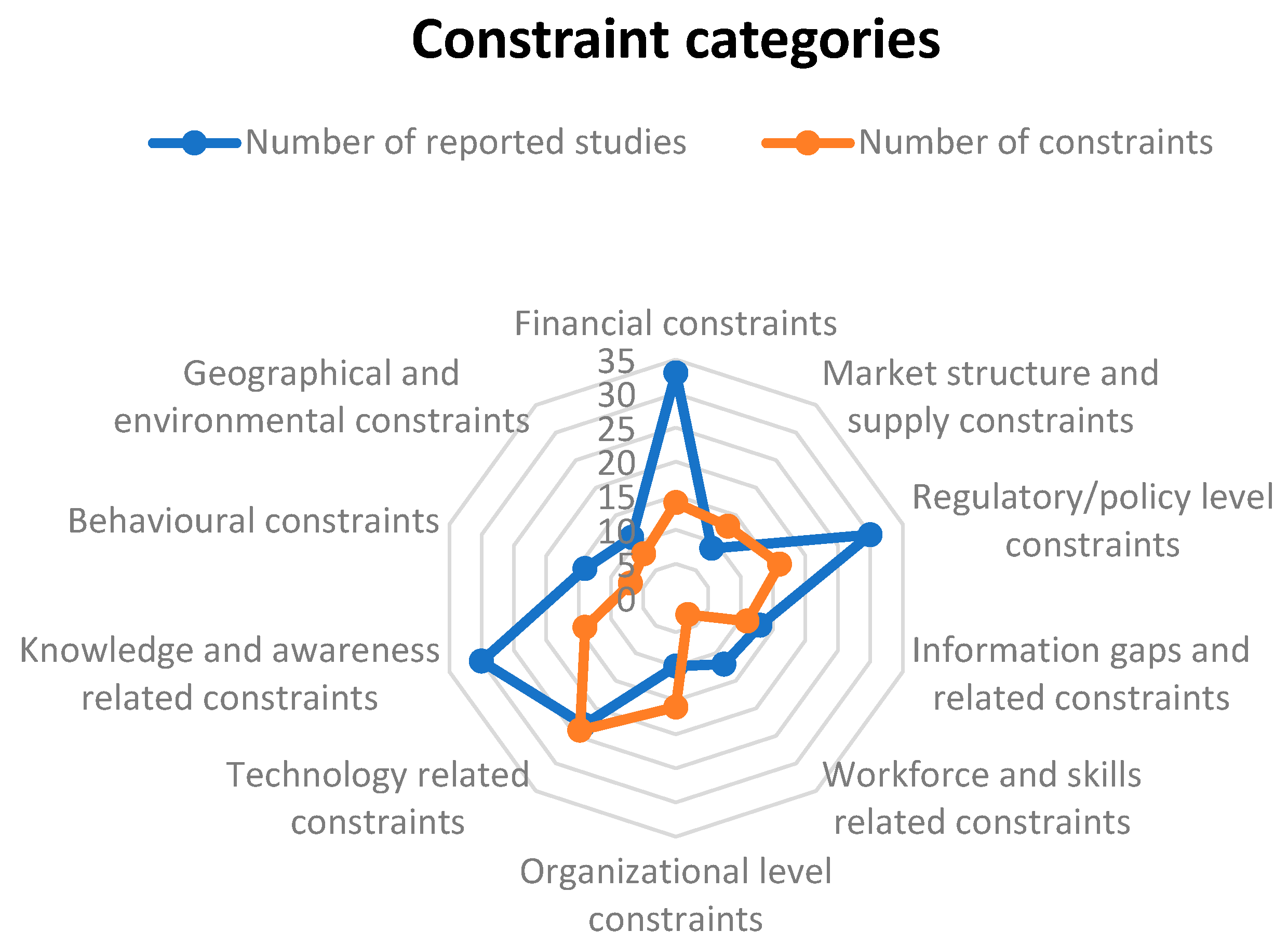
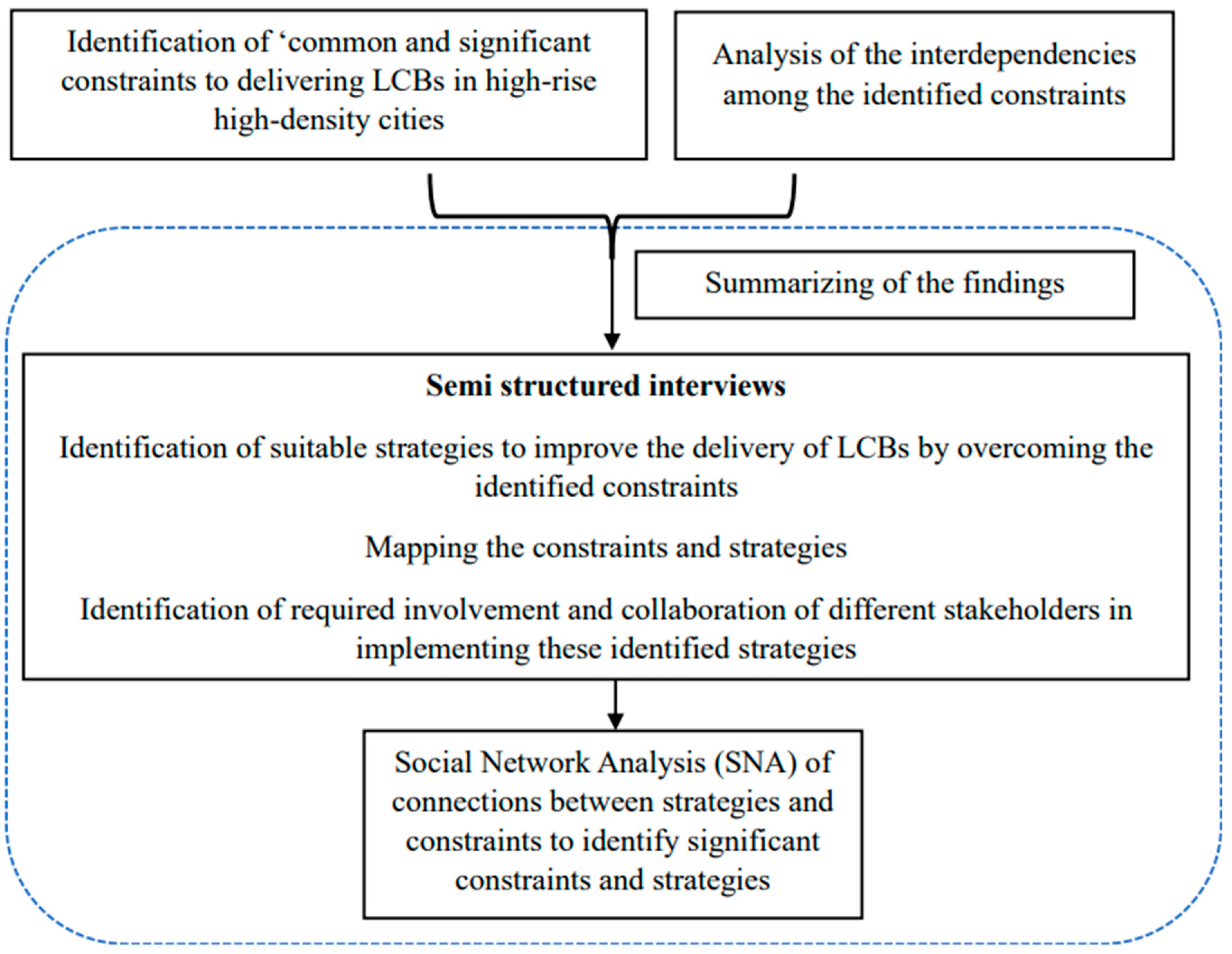
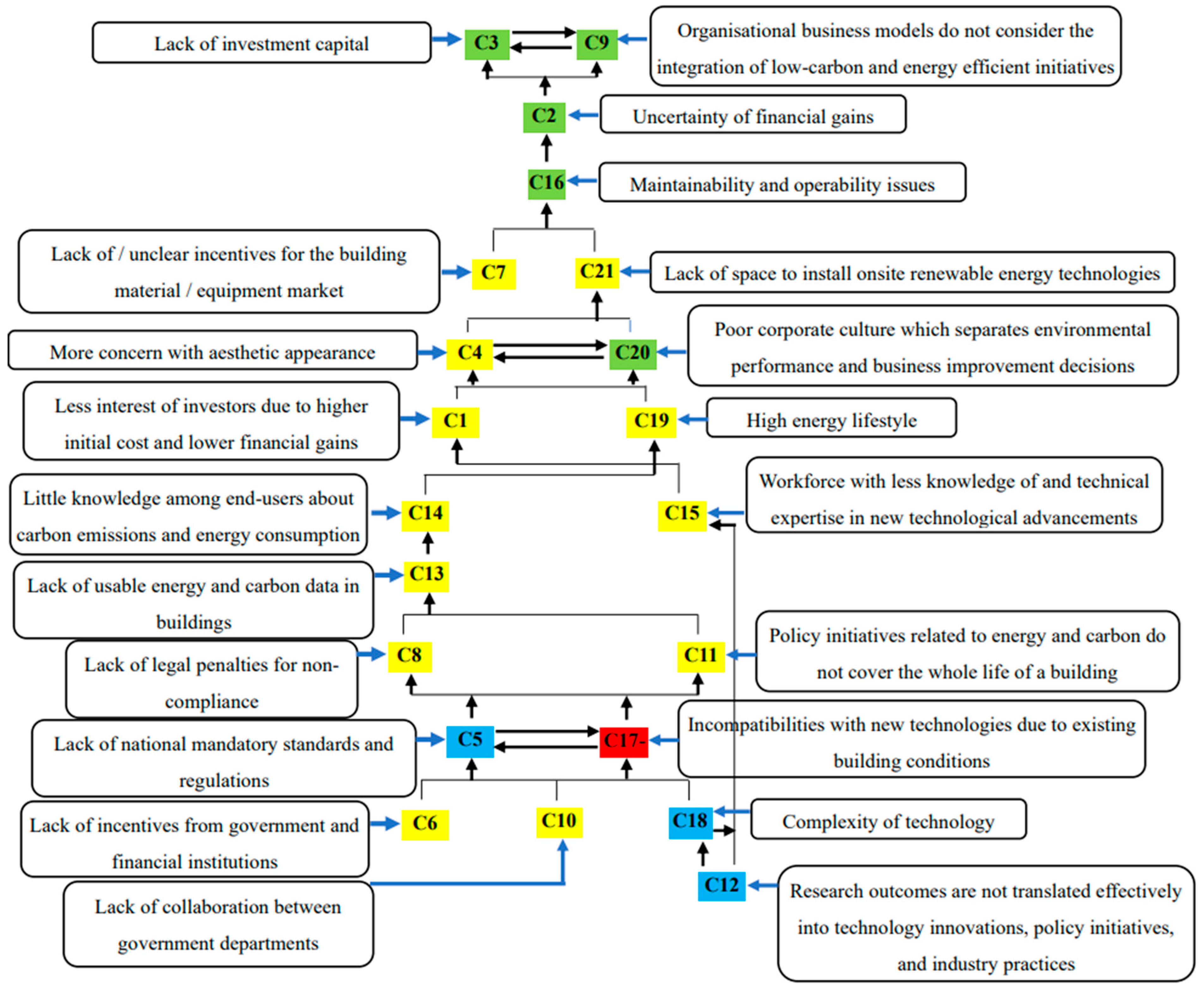
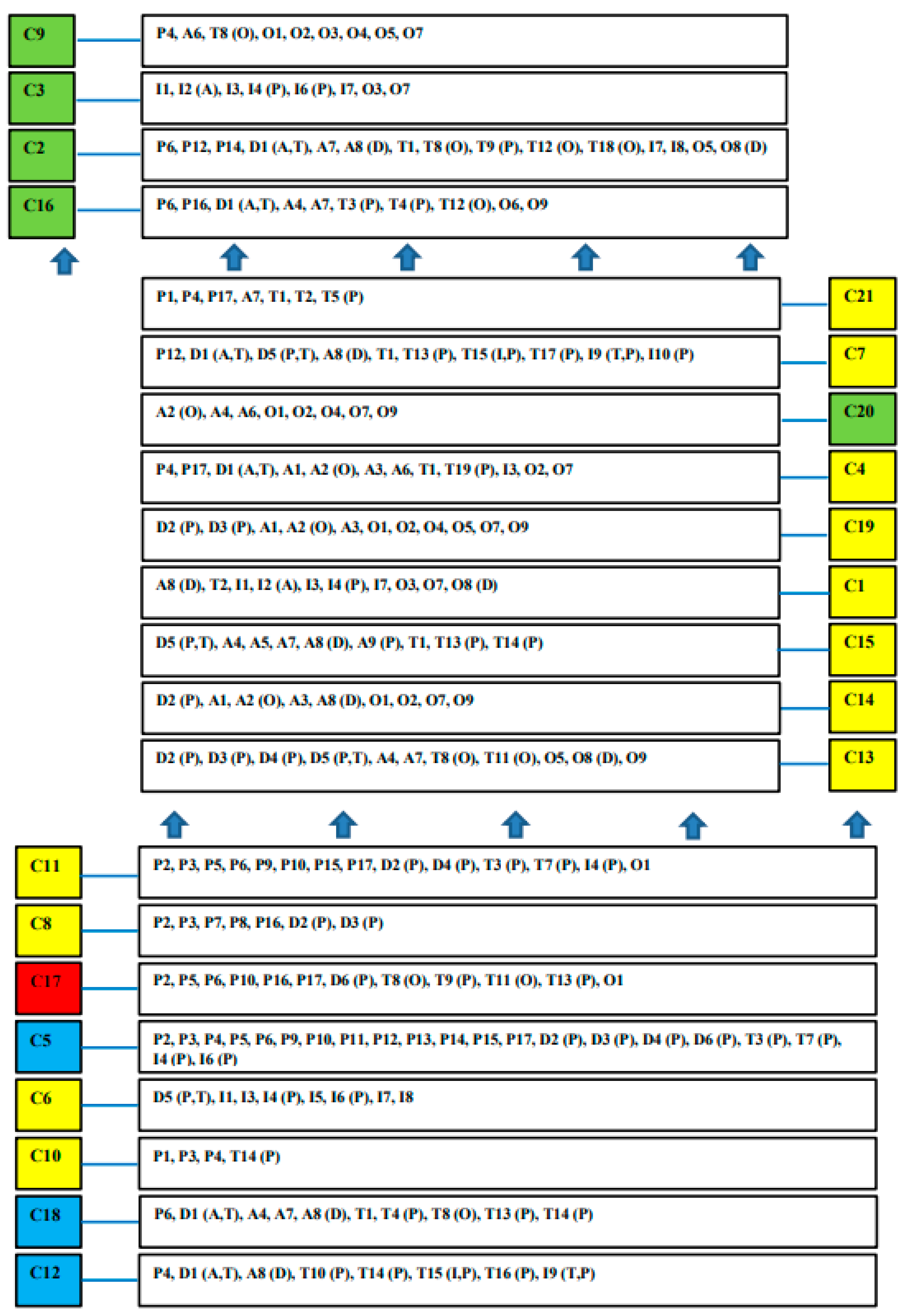
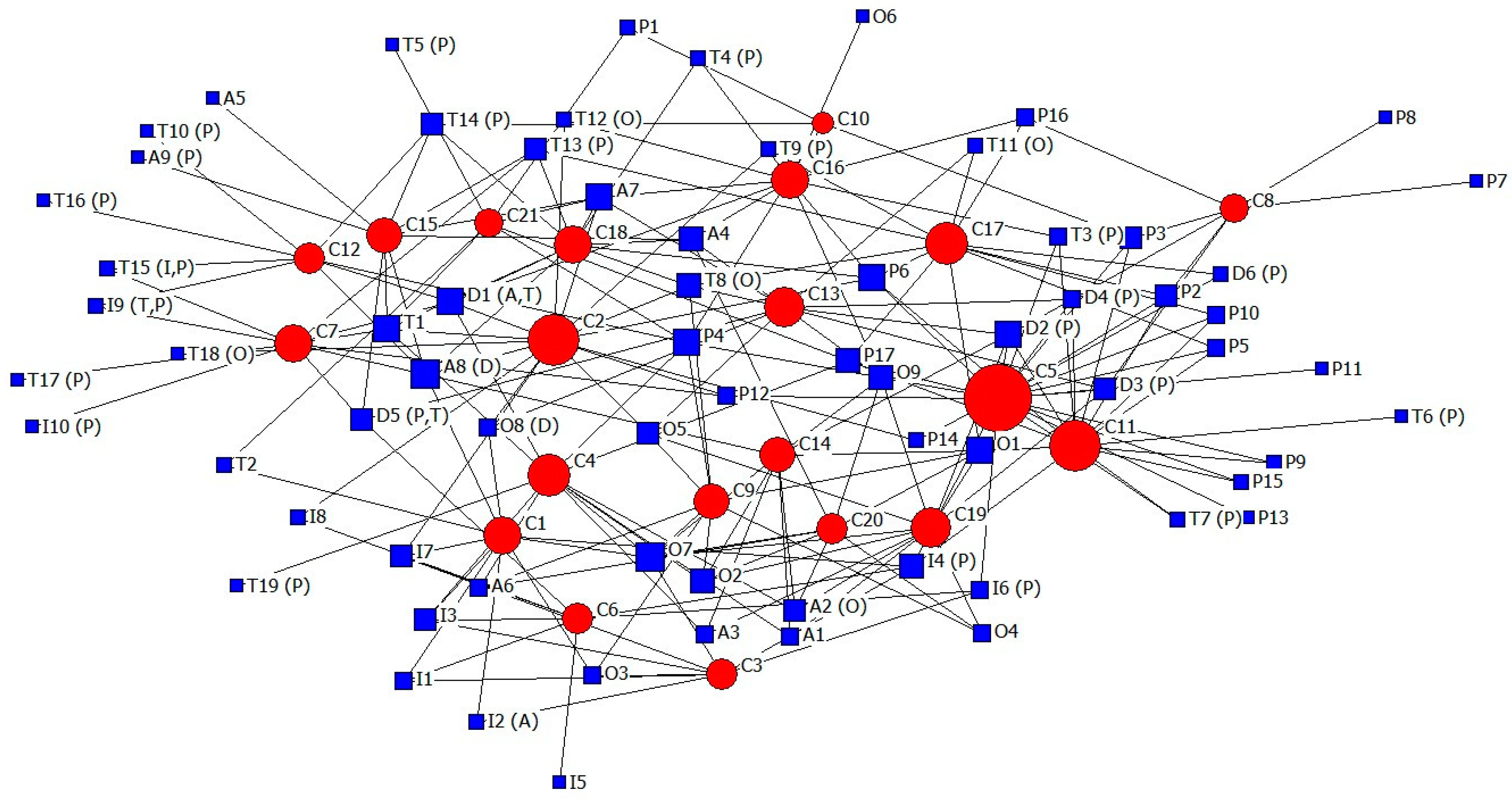
| Categories | Strategies |
|---|---|
| P1 | Decentralising the generation of electricity by proper urban planning |
| P2 | Implementing regulations on phasing out the systems, equipment, and materials with high-carbon emissions and less energy efficiency |
| P3 | Implementing national level realistic emission reduction policies and targets |
| P4 | Integrated policy initiatives for urban development |
| P5 | Mandating low-carbon retrofitting/refurbishment |
| P6 | Standardising construction and building materials |
| P7 | Implementing penalties, such as taxes for non-compliance, environmental tax, etc. |
| P8 | Introducing city or state-based energy benchmarks and fines for not achieving the benchmarks |
| P9 | Introducing regulations for building deconstruction and disposal |
| P10 | Introducing/updating the mandatory building energy codes |
| P11 | Labelling and certifying the new and existing buildings |
| P12 | Labelling (energy/carbon) for building materials, equipment, and systems |
| P13 | Introducing Life Cycle Analysis (LCA) regulations for building materials |
| P14 | Mandating the required minimum energy/carbon performance levels of appliances and equipment |
| P15 | Implementing regulations on thermal performance and embodied carbon emissions of building materials |
| P16 | Ensuring proper inspection of major refurbishments |
| P17 | Mandating structural provisions for onsite-renewable energy generation for new constructions |
| D1 (A,T) | Creating more opportunities for pilot projects, real-world examples, and sharing of performance data and evidences to build trust among investors |
| D2 (P) | Making energy audits compulsory for existing buildings and standardising the reporting procedures |
| D3 (P) | Mandating the disclosure of energy usage and carbon emissions |
| D4 (P) | Mandating LCA for major investments in the public sector |
| D5 (P,T) | Encouraging and supporting life cycle assessment (LCA) by providing relevant expertise and calculation tools |
| D6 (P) | Continuous improvement and reviewing of standards based on real world data |
| A1 | Raising awareness of the general public through various media platforms |
| A2(O) | Raising end-user awareness, encouraging behavioural changes, and influencing changing their attitudes |
| A3 | Including education on sustainability/emission reduction/energy efficiency to the school curriculums from primary education |
| A4 | Training and certification of energy managers and energy auditors through a regulatory body |
| A5 | Training relevant government sector officials |
| A6 | Training organisations to develop sustainable business models |
| A7 | Providing specialised training on relevant products, tools, systems and technologies |
| A8 (D) | Establishing databases/websites for relevant information sharing on energy-efficient and low-carbon initiatives (materials, equipment, technologies, suppliers, construction/installation methods/times/costs, energy/carbon performance data of materials/equipment/systems, payback information, important results of occupancy surveys/audits) |
| A9 (P) | Maintaining a pool of qualified energy and carbon auditors in the government sector |
| T1 | Demonstrating, prototyping, and providing examples of developed advanced energy efficient materials, equipment, and technologies |
| T2 | Exploring co-generation capacities and energy recovery opportunities |
| T3 (P) | Mandating the maintenance and servicing contracts with specialised and authorised service providers |
| T4 (P) | Ensuring the availability of globally applicable maintenance and servicing procedures for systems and equipment |
| T5 (P) | Assessing new constructions in terms of their potential for renewable energy generation and energy recovery |
| T6 (P) | Planning and implementing construction waste sorting and recycling facilities by the government or supporting the private sector to implement these facilities |
| T7 (P) | Implementing effective guidelines for building deconstruction and waste sorting |
| T8 (O) | Integration of BIM and utilisation of advanced tools at the design stage |
| T9 (P) | Validating the performances of new developments and evaluating the compliance with other requirements, such as safety and fire regulations |
| T10 (P) | Conducting research on reusing/recycling materials and minimising the usage of important natural resources |
| T11 (O) | Adopting building management systems with integrated controls |
| T12 (O) | Ensuring timely standardised maintenance and servicing of high energy-intensive systems and equipment |
| T13 (P) | Obtaining international-level assistance for technology advancement for LCBs |
| T14 (P) | Industry, academia, and government collaborations in research and technology adoption |
| T15 (I,P) | Financing the conversion of research and development (on technical advancements of materials, products and equipment) into manufacturing (through tax incentives, providing grants, etc.) |
| T16 (P) | Providing suitable research grants to universities |
| T17 (P) | Ensuring the support of the government for manufacturers and producers (who develop advanced high-efficient technical solutions) to bare the risk of entering into new markets |
| T18 (O) | Obtaining the best performances of the systems through following proper (standardised) installation, maintenance, and operational procedures |
| T19 (P) | Promoting circular design approaches for buildings |
| I1 | Offering attractive interest rates and longer tenure periods, incentives, such as grants, loans, and tax rebates, for low-carbon/energy efficient investments |
| I2 (A) | Raising awareness of financial institutions on financing low-carbon, energy efficient, and green building initiatives |
| I3 | Offering incentives to encourage the building owners to consider more decentralised power generation options |
| I4 (P) | Establishing policies to finance the onsite renewable energy generation in buildings |
| I5 | Providing attractive tariff rates for feeding power to the national grid through renewable energy generation in buildings |
| I6 (P) | Link financing procedures with the building energy/carbon certifications and standards |
| I7 | Financing for low-carbon initiatives through energy service providers/companies (ESCOs) by initiating performance-based contracts |
| I8 | Offering long-term warranties for the systems and equipment |
| I9 (T,P) | Offering incentives for manufacturing industries to invest in productive research and development |
| I10 (P) | Providing incentives, such as rebates for taxes and loans for energy efficient/low-carbon product development |
| O1 | Establishing and following internal compliance procedures and energy/carbon policies in organisations |
| O2 | Establishing an energy-efficient/low-carbon culture within organisations |
| O3 | Developing organisational internal funding models to support investments in energy-efficient and low-carbon initiatives/procurement procedures to consider LCA, LCC |
| O4 | Delegation of responsibilities for low-carbon, energy-efficient, and sustainability-related initiatives within organisations |
| O5 | Generating, processing, and analysing the building-level data related to energy usage, carbon emissions, behaviour patterns, equipment/system performances, etc. |
| O6 | Adopting sustainable maintenance procedures |
| O7 | Incorporate energy saving and carbon reduction into their internal business models |
| O8 (D) | Determining building-specific initiatives (e.g., phasing out less efficient systems, demand management, load shedding, adjustment of operational procedures, investments in new energy/carbon efficient systems, adopting energy management systems) based on the generated data and information through building-level audits/surveys |
| O9 | Implementing effective energy management procedures in buildings |
| Strategy ID | P1 | P2 | P3 | P4 | P5 | P6 | P7 | P8 | P9 | P10 | P11 |
| DC | 2 | 4 | 4 | 6 | 3 | 6 | 1 | 1 | 2 | 3 | 1 |
| Strategy ID | P12 | P13 | P14 | P15 | P16 | P17 | D1 (A,T) | D2 (P) | D3 (P) | D4 (P) | D5 (P,T) |
| DC | 3 | 1 | 2 | 2 | 3 | 5 | 6 | 6 | 4 | 3 | 4 |
| Strategy ID | D6 (P) | A1 | A2 (O) | A3 | A4 | A5 | A6 | A7 | A8 (D) | A9 (P) | T1 |
| DC | 2 | 3 | 4 | 3 | 5 | 1 | 3 | 6 | 7 | 1 | 6 |
| Strategy ID | T2 | T3 (P) | T4 (P) | T5 (P) | T6 (P) | T7 (P) | T8 (O) | T9 (P) | T10 (P) | T11 (O) | T12 (O) |
| DC | 2 | 3 | 2 | 1 | 1 | 2 | 5 | 2 | 1 | 2 | 2 |
| Strategy ID | T13 (P) | T14 (P) | T15 (I,P) | T16 (P) | T17 (P) | T18 (O) | T19 (P) | I1 | I2 (A) | I3 | I4 (P) |
| DC | 4 | 4 | 2 | 1 | 1 | 1 | 1 | 3 | 2 | 4 | 5 |
| Strategy ID | I5 | I6 (P) | I7 | I8 | I9 (T,P) | I10 (P) | O1 | O2 | O3 | O4 | O5 |
| DC | 1 | 3 | 4 | 2 | 2 | 1 | 6 | 5 | 3 | 3 | 4 |
| Strategy ID | O (6) | O (7) | O8 (D) | O9 | |||||||
| DC | 1 | 7 | 3 | 5 | |||||||
| Constraint ID | C1 | C2 | C3 | C4 | C5 | C6 | C7 | C8 | C9 | C10 | C11 |
| DC | 10 | 15 | 8 | 12 | 21 | 8 | 10 | 7 | 9 | 4 | 15 |
| Constraint ID | C12 | C13 | C14 | C15 | C16 | C17 | C18 | C19 | C20 | C21 | |
| DC | 8 | 11 | 9 | 9 | 10 | 12 | 10 | 11 | 8 | 7 |
Disclaimer/Publisher’s Note: The statements, opinions and data contained in all publications are solely those of the individual author(s) and contributor(s) and not of MDPI and/or the editor(s). MDPI and/or the editor(s) disclaim responsibility for any injury to people or property resulting from any ideas, methods, instructions or products referred to in the content. |
© 2023 by the authors. Licensee MDPI, Basel, Switzerland. This article is an open access article distributed under the terms and conditions of the Creative Commons Attribution (CC BY) license (https://creativecommons.org/licenses/by/4.0/).
Share and Cite
Kumaraswamy, M.M.; Hewa Welege, N.M.; Pan, W. Accelerating the Delivery of Low-Carbon Buildings by Addressing Common Constraints: Perspectives from High-Rise, High-Density Cities. Buildings 2023, 13, 1455. https://doi.org/10.3390/buildings13061455
Kumaraswamy MM, Hewa Welege NM, Pan W. Accelerating the Delivery of Low-Carbon Buildings by Addressing Common Constraints: Perspectives from High-Rise, High-Density Cities. Buildings. 2023; 13(6):1455. https://doi.org/10.3390/buildings13061455
Chicago/Turabian StyleKumaraswamy, Mohan M., Nandun Madhusanka Hewa Welege, and Wei Pan. 2023. "Accelerating the Delivery of Low-Carbon Buildings by Addressing Common Constraints: Perspectives from High-Rise, High-Density Cities" Buildings 13, no. 6: 1455. https://doi.org/10.3390/buildings13061455
APA StyleKumaraswamy, M. M., Hewa Welege, N. M., & Pan, W. (2023). Accelerating the Delivery of Low-Carbon Buildings by Addressing Common Constraints: Perspectives from High-Rise, High-Density Cities. Buildings, 13(6), 1455. https://doi.org/10.3390/buildings13061455







